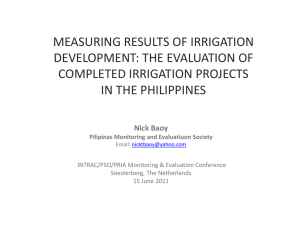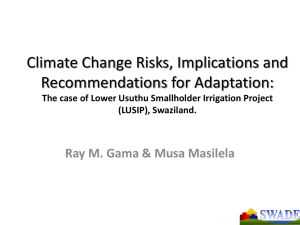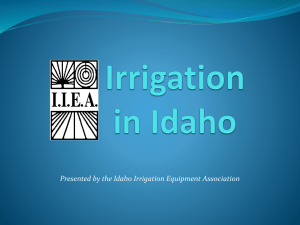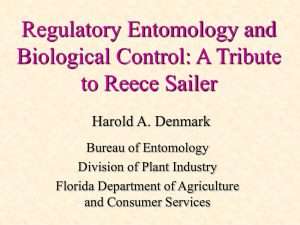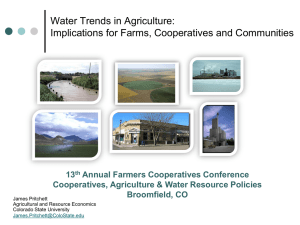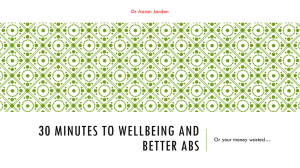b Number of waveforms events performed per irrigation treatment.
advertisement
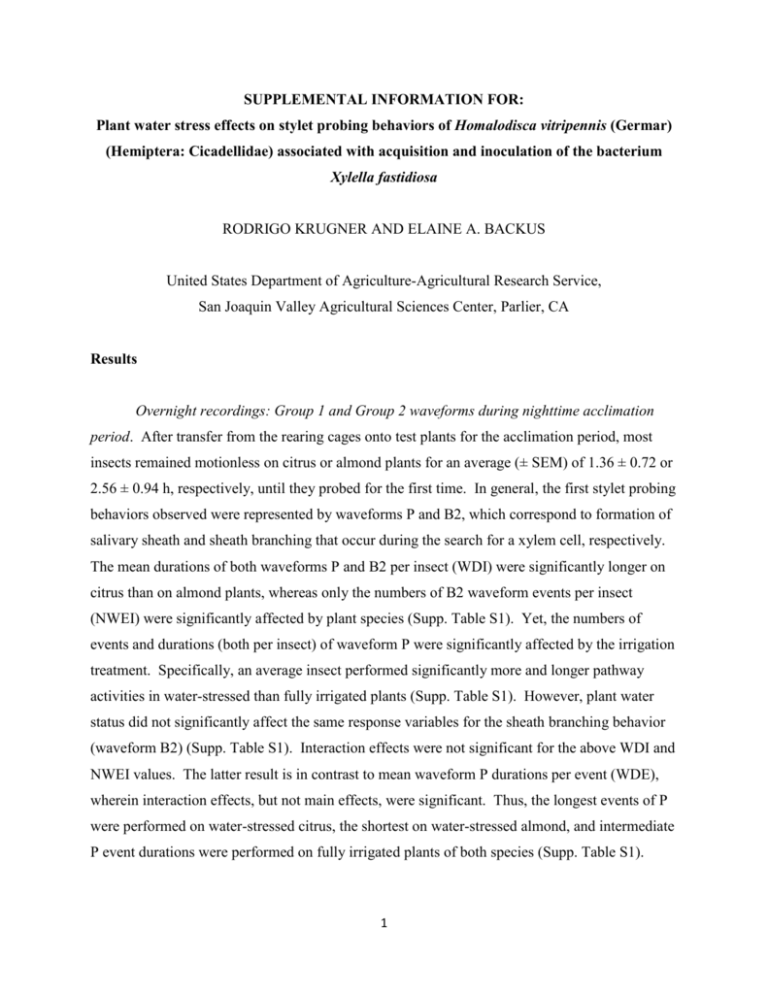
SUPPLEMENTAL INFORMATION FOR: Plant water stress effects on stylet probing behaviors of Homalodisca vitripennis (Germar) (Hemiptera: Cicadellidae) associated with acquisition and inoculation of the bacterium Xylella fastidiosa RODRIGO KRUGNER AND ELAINE A. BACKUS United States Department of Agriculture-Agricultural Research Service, San Joaquin Valley Agricultural Sciences Center, Parlier, CA Results Overnight recordings: Group 1 and Group 2 waveforms during nighttime acclimation period. After transfer from the rearing cages onto test plants for the acclimation period, most insects remained motionless on citrus or almond plants for an average (± SEM) of 1.36 ± 0.72 or 2.56 ± 0.94 h, respectively, until they probed for the first time. In general, the first stylet probing behaviors observed were represented by waveforms P and B2, which correspond to formation of salivary sheath and sheath branching that occur during the search for a xylem cell, respectively. The mean durations of both waveforms P and B2 per insect (WDI) were significantly longer on citrus than on almond plants, whereas only the numbers of B2 waveform events per insect (NWEI) were significantly affected by plant species (Supp. Table S1). Yet, the numbers of events and durations (both per insect) of waveform P were significantly affected by the irrigation treatment. Specifically, an average insect performed significantly more and longer pathway activities in water-stressed than fully irrigated plants (Supp. Table S1). However, plant water status did not significantly affect the same response variables for the sheath branching behavior (waveform B2) (Supp. Table S1). Interaction effects were not significant for the above WDI and NWEI values. The latter result is in contrast to mean waveform P durations per event (WDE), wherein interaction effects, but not main effects, were significant. Thus, the longest events of P were performed on water-stressed citrus, the shortest on water-stressed almond, and intermediate P event durations were performed on fully irrigated plants of both species (Supp. Table S1). 1 The numbers of events and durations per insect for sharpshooter resting behaviors with the stylets inserted in the plant but motionless (i.e., waveform R, stylets outside xylem; waveform G, stylets inside xylem) were not significantly affected by irrigation treatment. However, the duration per insect of waveform G was significantly longer on citrus than on almond plants (Supp. Table S2). In contrast, events of waveform U (i.e., unknown behavior) were observed significantly more often and lasted longer (once totaled and averaged per insect for WDI) in almond than in citrus plants. Irrigation treatment did not significantly affect the duration of waveform U per insect, but it did significantly affect the number of U events per insect; a larger number of events of this unknown behavior were performed on water-stressed than on fully irrigated plants (Supp. Table S2). Mean durations per events (WDE) for waveform R were significantly different for main irrigation effects and for interactions; thus, R events were longest on water-stressed citrus, with all other treatment combinations not significantly different. Results for G events were different from R; both plant effects and plant × irrigation interaction effects were significant, revealing that the longest G events were those recorded on fully irrigated citrus. Events of unknown (U) waveform were significantly shorter on citrus compared with almond plants, but not different for irrigation or interaction effects (Supp. Table S2). Overnight recordings: Group 3 waveforms during nighttime acclimation period. Irrigation status did not significantly affect the numbers of events and durations (both per insect) of XN, XC and C2 (Supp. Table S3). However, the numbers of events and durations (per insect) of waveform XN were significantly lower on citrus than almond plants. Also, while events of waveform XC were observed significantly less often on citrus than on almond plants, there was no significant plant species effect on the durations of waveform XC per insect. Neither NWEI nor WDI for sustained xylem sap ingestion (C2) were significantly affected by plant species or irrigation treatment during the overnight acclimation period (Supp. Table S3). Mean event durations (WDE) for all three X wave components were significantly different for plant species main effects, but not for irrigation or plant × irrigation interactions. Thus, events of both XN and XC were longer on citrus compared with almond, but events of C2 (sustained xylem fluid ingestion) were longer (accepting a P value of 0.056 as significant). However, irrigation status did not affect per-event durations of X waves or sustained ingestion (Supp. Table S3). 2 Daytime recordings: Group 1 and Group 2 waveforms during daytime conditions. In general, behaviors performed during the search for a xylem cell (waveforms P and B2) were not affected by plant water stress. On a per-insect basis, there were no differences between fully irrigated and water-stressed plants in both numbers of events and durations of these pathway behaviors (Supp. Table S4). However, there was a plant species effect in the P duration per insect, being longer when performed on citrus than almond plants (Supp. Table S4). There also was no difference in the B2 duration per insect, or in the number of events of both waveforms P and B2 between plant species. Nonetheless, when the duration of individual waveform events (WDE) were analyzed, both plant species and irrigation treatment affected the P event duration. P events were longer on citrus than almond plants; shorter on water-stressed than fully irrigated almond plants, and longer on water-stressed than fully irrigated citrus plants (Supp. Table S4). Similar to the behaviors performed during the search for a xylem cell, sharpshooter resting behaviors with stylets inserted in the plant (waveforms R and G) were generally not affected by irrigation treatment or plant species (Supp. Table S4). The exceptions were for the numbers of events of waveform R per insect, which were larger in water-stressed than in fully irrigated plants, and the durations of waveform G per insect, which were shorter in almond than on citrus plants. Host plant effect for waveform U (unknown biological meaning), for the waveform durations per insect, the number of events per insect, and the durations of waveform events, were all shorter on citrus than on almond plants (Supp. Table S4). Irrigation treatment did not affect the overall durations or numbers of events of U per insect, but it did affect the durations of individual waveform events; U events were shorter on fully irrigated than on waterstressed plants (Supp. Table S4). Discussion Overnight recordings: Group 1 and Group 2 waveforms during nighttime acclimation period. During the overnight acclimation period, plant species had the greatest effect on stylet probing behaviors. After being placed on test plants, insects remained motionless for about 2 h before initiating the searching behaviors. Once stylet probing commenced, the average insect made longer, more frequent events of pathway/searching behavior (waveforms P and B2) on citrus than on almond plants; when combined, these changes caused more overall pathway/searching durations per insect, especially on water-stressed citrus. In addition, there 3 were shorter and less frequent events of the unknown behavior (U) on citrus than on almond. These unknown behaviors were performed throughout the 10-h period. Overnight recordings: Group 3 waveforms during nighttime acclimation period. Once an average insect’s stylets reached the xylem, salivation/egestion (XN) and trial ingestion (XC) behaviors in xylem cells were strongly affected by host plant. All salivation/egestion events, of the same per-event duration, were performed more often on almond than on citrus; this resulted in longer durations of the xylem-testing behaviors, per insect. Similarly, fewer trial ingestion events (of the same per-event duration) were performed on citrus than almond; however, there was not enough difference to result in a shorter duration, per insect. Neither plant species nor irrigation treatment significantly affected any measure of sustained xylem fluid ingestion. The exception was for the WDE, which was longer in almond than citrus plants. However, while insects performed sustained ingestion of xylem fluid (C2) from both almond and citrus plants, they did so about four and ten times less than during the daytime ingestions, respectively. Stylet resting (either in xylem [G] or more shallowly in other tissues of the plant [R]) often followed an event of sustained egestion; however, stylet resting was performed about the same, regardless of treatment. Most stylet resting also occurred very late in the first 10-h period, primarily between 0200 and 0600 h, before dawn and lights-on regime. The above behavioral findings on citrus (compared with almond) match that performed by sharpshooters on a less-preferred host plant, in which searching and acceptance behaviors require more time and energy than on a highly preferred plant. An insect’s search ultimately ends in sustained xylem fluid ingestion. One explanation for the significant plant species effect (in the first 10 h) on pathway/ salivary sheath/ branching behaviors (indicating higher degree of difficulty in searching for a xylem cell) is that it is more difficult for naïve insects to locate xylem cells in citrus than almond plants. Our test insects had never experienced feeding on almond or citrus plants before EPG recording. Physical impediments such as lignification of cell walls and location/depth of xylem cells could influence the amount of time needed for searching, being more difficult for naïve insects on citrus than on almond plants. Another explanation for the lack of a significant irrigation treatment effect during the nighttime recordings is that insects were well fed when placed on the plants, not having been subjected to a pre-test starvation period. Short nighttime xylem fluid ingestion may be more important to prevent dehydration and/or starvation than to provide the energy and nutrients needed for maintenance and reproduction. 4 Supplemental Material Table S1. Mean (±SEM) numbers of events and durations of P and B2 waveform variables calculated from electrical penetration graph recordings of Homalodisca vitripennis feeding behaviors during the first 10 h (nighttime) period on fully irrigated and water-stressed almond and citrus plants Plant Irrigation Waveform duration (sec) Number of waveform Waveform duration (sec) treatment per insect (WDI) events per insect (NWEI) per event (WDE) P - pathway (excluding B2) Water-stressed 561.20 ± 79.91 Aa 7a 17.57 ± 3.44 Aa 7a 31.94 ± 3.16 a 123b Fully irrigated 376.46 ± 131.99 Ab 8 9.50 ± 3.12 Ab 8 39.63 ± 3.81 bc 76 9 23.22 ± 3.46 Aa 9 53.73 ± 4.82 c 209 679.00 ± 162.04 Bb 8 16.13 ± 3.42 Ab 8 42.11 ± 3.80 ab 129 Almond Water-stressed 1247.73 ± 233.02 Ba Citrus Fully irrigated F df P F df P F df P Plant species effect 8.34 28 0.007 3.71 28 0.064 1.07 533 0.302 Irrigation treatment effect 8.15 28 0.008 6.62 28 0.015 0.43 533 0.511 Plant × Irrigation treatment 10.78 533 0.001 B2 - sheath branching 5 Water-stressed 93.37 ± 18.74 Aa 7 13.29 ± 3.28 Aa 7 7.03 ± 0.31 Aa 93 Fully irrigated 59.61 ± 20.43 Aa 7 7.43 ± 2.83 Aa 7 8.02 ± 0.50 Aa 52 Almond Water-stressed 108.78 ± 18.07 Ba 9 16.00 ± 2.59 Ba 9 6.80 ± 0.29 Aa 144 Fully irrigated 114.95 ± 22.85 Ba 7 13.86 ± 2.74 Ba 7 8.30 ± 0.90 Aa 97 Citrus F df P F df P F df P Plant species effect 5.54 26 0.026 4.11 26 0.053 2.75 382 0.098 Irrigation treatment effect 1.64 26 0.211 2.94 26 0.098 2.59 382 0.108 a Number of insects that performed the feeding behavior per irrigation treatment. b Number of waveforms events performed per irrigation treatment. Different lower case letters in columns indicate significant differences between irrigation treatments (α = 0.05). Different upper case letters in columns indicate significant differences between plant species (α = 0.05). 6 Table S2. Mean (±SEM) numbers of events and durations of R, G and U waveform variables calculated from electrical penetration graph recordings of Homalodisca vitripennis feeding behaviors during the first 10 h (nighttime) period on fully irrigated and waterstressed almond and citrus plants Plant Irrigation Waveform duration (sec) Number of waveform Waveform duration (sec) treatment per insect (WDI) events per insect (NWEI) per event (WDE) R - stylets resting outside xylem Water-stressed 5920.67 ± 2168.77 Aa 6a 8.17 ± 2.96 Aa 6a 724.98 ± 70.48 a 49b Fully irrigated 6984.81 ± 3557.05 Aa 6 8.67 ± 2.69 Aa 6 805.94 ± 112.55 a 52 Water-stressed 11758.83 ± 3748.22 Aa 7 9.14 ± 2.47 Aa 7 1286.12 ± 213.58 b 64 Aa 6 3.33 ± 0.71 Aa 6 Almond Citrus Fully irrigated 1848.93 ± 350.06 P F df 78.95 a F df P F Plant species effect 0.01 21 0.927 0.73 21 0.401 0.11 181 0.735 Irrigation treatment effect 1.97 21 0.174 1.19 21 0.288 6.79 181 0.099 Plant × Irrigation treatment df 554.68 ± P 7.46 181 0.007 G - stylets resting inside xylem 7 20 Water-stressed 3011.87 ± 1159.65 Aa 7 5.86 ± 1.55 Aa 7 514.22 ± 99.86 a 41 Fully irrigated 2526.74 ± 898.58 Aa 7 6.00 ± 1.30 Aa 8 421.12 ± 80.28 a 48 Water-stressed 9579.30 ± 2520.25 Ba 9 9.67 ± 2.06 Aa 9 990.96 ± 267.41 a 87 Fully irrigated 16528.48 ± 5343.88 Ba 7 8.29 ± 1.92 Aa 7 1994.82 ± 364.23 b 58 Almond Citrus F df P F df P F Plant species effect 18.79 27 0.0002 2.74 27 0.109 7.82 230 0.005 Irrigation treatment effect 1.10 27 0.303 0.05 27 0.817 2.22 230 0.137 Plant × Irrigation treatment df P 7.96 230 0.005 U - unknown behavior Water-stressed 9172.36 ± 2659.14 Aa 6 17.67 ± 3.00 Aa 6 519.19 ± 93.95 Aa 106 Fully irrigated 10953.27 ± 2567.35 Aa 8 10.75 ± 2.99 Ab 8 1018.91 ± 200.27 Aa 86 Water-stressed 3574.56 ± 1946.97 Ba 8 7.88 ± 2.25 Ba 8 453.91 ± 121.15 Ba 63 Fully irrigated 2365.94 ± 1915.31 Ba 7 3.14 ± 0.91 Bb 7 752.80 ± 413.15 Ba 22 Almond Citrus Plant species effect F df P 20.62 25 0.0001 F df P 14.58 25 0.0008 8 F df P 8.36 273 0.004 Irrigation treatment effect 0.25 25 0.620 6.72 25 0.015 a Number of insects that performed the feeding behavior per irrigation treatment. b Number of waveforms events performed per irrigation treatment. 0.93 273 0.335 Different lower case letters in columns indicate significant differences between irrigation treatments (α = 0.05). Different upper case letters in columns indicate significant differences between plant species (α = 0.05). 9 Table S3. Mean (±SEM) numbers of events and durations of XN, XC and C2 waveform variables calculated from electrical penetration graph recordings of Homalodisca vitripennis feeding behaviors during the first 10 h (nighttime) period on fully irrigated and water-stressed almond and citrus plants Plant Irrigation Waveform duration (sec) treatment per insect (WDI) Number of waveform Waveform duration (sec) events per insect per event (WDE) (NWEI) XN - xylem contact Water-stressed 273.15 ± 46.30 Aa 7a 15.43 ± 2.89 Aa 7a 17.70 ± 1.24 Aa 108b Fully irrigated 189.50 ± 23.23 Aa 8 10.00 ± 1.30 Aa 8 18.95 ± 1.55 Aa 80 Water-stressed 179.70 ± 31.87 Ba 9 7.22 ± 1.26 Ba 9 24.88 ± 2.38 Ba 65 Fully irrigated 136.50 ± 39.17 Ba 8 6.75 ± 2.09 Ba 8 20.22 ± 1.50 Ba 54 Almond Citrus F df P F df P F df P Plant species effect 6.01 28 0.020 10.29 28 0.003 9.55 303 0.002 Irrigation treatment effect 3.51 28 0.071 2.08 0.22 303 0.638 28 0.159 XC - trial ingestion Almond Water-stressed 934.45 ± 209.38 Aa 7 14.57 ± 2.40 10 Aa 7 64.13 ± 6.13 Aa 102 Fully irrigated 458.92 ± 61.08 Aa 8 9.50 ± 0.96 Aa 8 48.31 ± 4.65 Aa 76 Water-stressed 534.39 ± 120.97 Aa 8 7.00 ± 1.16 Ba 8 76.34 ± 7.52 Ba 56 Fully irrigated 581.40 ± 148.27 Aa 8 6.75 ± 1.77 Ba 8 86.13 ± 12.83 Ba 54 Citrus F df P F df P F df P Plant species effect 1.22 27 0.278 10.30 27 0.003 16.39 284 < 0.0001 Irrigation treatment effect 1.50 27 0.231 2.11 0.73 27 0.157 284 0.394 C2 - sustained ingestion Water-stressed 4002.64 ± 1773.76 Aa 7 3.43 ± 0.72 Aa 7 1167.44 ± 321.99 Aa 24 Fully irrigated 4061.02 ± 2185.56 Aa 4 3.00 ± 1.41 Aa 4 1353.67 ± 376.72 Aa 12 Water-stressed 1859.65 ± 743.82 Aa 6 2.50 ± 0.62 Aa 6 743.86 ± 152.80 Ba 15 Fully irrigated 1673.40 ± 548.36 Aa 4 3.00 ± 0.91 Aa 4 557.80 ± Almond Citrus F df P F df P 77.68 Ba 12 F df P Plant species effect 0.84 17 0.372 0.15 17 0.702 3.80 59 0.056 Irrigation treatment effect 0.01 17 0.904 0.01 17 0.925 0.12 59 0.727 a Number of insects that performed the feeding behavior per irrigation treatment. b Number of waveforms events performed per irrigation treatment. 11 Different lower case letters in columns indicate significant differences between irrigation treatments (α = 0.05). Different upper case letters in columns indicate significant differences between plant species (α = 0.05). 12 Table S4. Mean (±SEM) numbers of events and durations of P, B2, R, G and U waveform variables calculated from electrical penetration graph recordings of Homalodisca vitripennis feeding behaviors during the second 10 h (daytime) period on fully irrigated and water-stressed almond and citrus plants Plant Irrigation treatment Waveform duration (sec) per Number of waveform events per insect insect (WDI) Waveform duration (sec) per event (WDE) (NWEI) P - pathway (excluding B2) Almond Citrus Water-stressed 832.99 ± 285.16 Aa 6a 22.33 ± 7.66 Aa 6a 37.30 ± 3.27 Aa 134b Fully irrigated 1136.77 ± 317.68 Aa 8 27.13 ± 5.71 Aa 8 41.91 ± 7.79 Ab 217 Water-stressed 1375.16 ± 272.83 Ba 9 28.56 ± 5.75 Aa 9 48.16 ± 3.47 Ba 257 Fully irrigated 1953.77 ± 745.99 Ba 9 44.56 ± 12.96 Aa 9 43.85 ± 2.69 Bb 401 F df P F df P F df P Plant species effect 4.50 28 0.043 2.23 28 0.146 3.93 1005 0.048 Irrigation treatment effect 1.18 28 0.286 1.59 28 0.218 7.37 1005 0.007 B2 - sheath branching Almond Citrus Water-stressed 171.20 ± 40.34 Aa 4 21.75 ± 5.86 Aa 4 7.87 ± 0.39 Aa 140 Fully irrigated 127.58 ± 29.60 Aa 8 17.50 ± 4.61 Aa 8 7.29 ± 0.35 Aa 56 Water-stressed 124.75 ± 35.74 Aa 9 19.00 ± 5.04 Aa 9 6.57 ± 0.28 Ba 171 Fully irrigated 229.97 ± 88.97 Aa 9 31.67 ± 11.44 Aa 9 7.26 ± 0.30 Ba 285 F Plant species effect 0.05 df P F 26 0.821 df P 0.26 26 0.615 13 F df P 8.25 679 0.004 Irrigation treatment effect 0.01 26 0.908 0.08 26 0.779 1.06 679 0.304 R - stylet resting outside xylem Almond Citrus Water-stressed 6990.79 ± 3729.49 Aa 4 7.75 ± 3.94 Aa 4 902.04 ± 91.45 Aa 31 Fully irrigated 3796.70 ± 1650.21 Aa 6 5.33 ± 1.54 Ab 6 711.88 ± 101.99 Aa 32 Water-stressed 8141.26 ± 1687.87 Aa 7 10.00 ± 2.33 Aa 7 814.13 ± 108.65 Aa 70 Fully irrigated 3293.91 ± 1428.87 Aa 6 2.33 ± 0.61 Ab 6 1411.67 ± 665.34 Aa 14 F df P F df P F df P Plant species effect 0.34 19 0.560 0.02 19 0.895 0.71 143 0.402 Irrigation treatment effect 1.97 19 0.176 4.22 19 0.054 0.90 143 0.344 Water-stressed 2881.23 ± 1211.95 Aa 6 6.00 ± 2.56 Aa 6 480.20 ± 80.69 Aa 36 Fully irrigated 3950.43 ± 1861.73 Aa 8 6.63 ± 1.82 Aa 8 596.29 ± 118.55 Aa 53 Water-stressed 7020.84 ± 1961.78 Ba 9 9.67 ± 2.51 Aa 9 726.29 ± 115.51 Aa 87 Fully irrigated 9366.97 ± 2246.08 Ba 9 8.67 ± 2.17 Aa 9 1080.80 ± 166.17 Aa 78 G - stylet resting in xylem Almond Citrus F df P F df P F df P Plant species effect 9.04 28 0.005 1.90 28 0.179 0.15 250 0.703 Irrigation treatment effect 1.77 28 0.194 0.00 28 0.954 0.05 250 0.815 U - unknown behavior Almond Citrus Water-stressed 13671.95 ± 4008.42 Aa 5 16.60 ± 2.32 Aa 5 823.61 ± 147.79 Aa 83 Fully irrigated 8519.03 ± 2229.90 Aa 8 11.50 ± 3.54 Aa 8 740.79 ± 128.59 Ab 92 Water-stressed 6426.27 ± 3905.12 Ba 8 8.38 ± 3.36 Ba 8 767.32 ± 232.94 Ba 67 Fully irrigated 2615.73 ± 2081.31 Ba 9 7.00 ± 3.66 Ba 9 373.68 ± 207.17 Bb 63 14 F df P F df P F df P Plant species effect 13.81 26 0.001 5.12 26 0.032 37.06 301 < 0.0001 Irrigation treatment effect 0.96 26 0.336 1.16 26 0.291 23.50 301 < 0.0001 a Number of insects that performed the feeding behavior per irrigation treatment. b Number of waveforms events performed per irrigation treatment. Different lower case letters in columns indicate significant differences between irrigation treatments (α = 0.05). Different upper case letters in columns indicate significant differences between plant species (α = 0.05). 15


